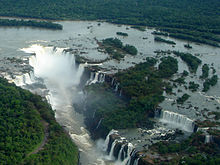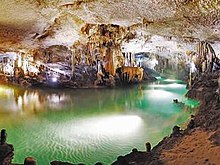Geotourism deals with the natural and built environments.[1]

Geological sustainable tourism aims to conserve and promote a place as a geosite, such as theIguazu Falls in South America
Geotourism was first defined (Hose, 1995) in England.[2] There are two viewpoints of geotourism:
- Purely geological and geomorphologically-focused Sustainable Tourism as abiotic nature based tourism.[1] This is the definition followed in most of the world.
- Geographically Sustainable Tourism, the most common definition in the USA. This emphasises preservation of the geographical sense of a place in general, beyond simple geological and geomorphological features, as a new charter & concept in the sustainable tourism.
Definitions of modern geotourism
Key definitions in the geological sense include:
- “…part of the tourist’s activity in which they have the geological patrimony as their main attraction. Their objective is to search for the protected patrimony through the conservation of their resources and of the tourist’s Environmental Awareness. For that, the use of the interpretation of the patrimony makes it accessible to the lay public, promoting its popularization and the development of the Earth sciences” .[3]
- “Geotourism is a knowledge -based tourism, an interdisciplinary integration of the tourism industry with conservation and interpretation of abiotic nature attributes, besides considering related cultural issues, within the geosites for the general public” .[1]
- "A form of natural area tourism that specifically focuses on landscape and geology. It promotes tourism to geosites and the conservation of geo-diversity and an understanding of Earth sciences through appreciation and learning. This is achieved through independent visits to geological features, use of geo-trails and view points, guided tours, geo-activities and patronage of geosite visitor centers".[4]
- “The provision of interpretative and service facilities for geosites and geomorphosites and their encompassing topography, together with their associated in-situ and ex-situ artefacts, to constituency-build for their conservation by generating appreciation, learning and research by and for current and future generations” .[2]
Geotourism, A New Approach
Most of the world defines geotourism as purely the study of geological and geomorphological features.
National Geographic Geotourism Program
The geographical-character definition of geotourism was heavily influenced by the National Geographic Society, which defines geotourism as tourism that sustains or enhances the geographical character of a place – its environment, culture, aesthetics, heritage, and the well-being of its residents. The concept of Geographical sustainable tourism with coining of the word geotourism, was introduced publicly in the USA in a 2002 report by the Travel Industry Association of America (as of 2009 this organization adapted name to U.S. Travel Association) and National Geographic Traveler magazine.[5]National Geographic senior editor Jonathan B. Tourtellot and his wife, Sally Bensusen, coined the term in 1997 in response to requests for a term and concept more encompassing thanecotourism and sustainable tourism.[6]
So National Geographic 'sGeotourism(NGG-tourism program) is "best practice" tourism that sustains, or even enhances, the geographicalcharacter of a place, such as its culture,environment, heritage, and the well-being of its residents.
National Geographic 's Geotourism program incorporates sustainabilityprinciples, but in addition to the do-no-harm ethic focuses on the place as a whole. The idea of enhancement allows for development based on character of place, rather than standardized international branding, and generic architecture, food, and so on.
National Geographic Geotourism Charter
- Integrity of place: Enhance geographical character by developing and improving it in ways distinctive to the local, reflective of its natural and cultural heritage, so as to encourage market differentiation and cultural pride.
- International codes: Adhere to the principles embodied in the World Tourism Organization’s Global Code of Ethics for Tourism and the Principles of the Cultural Tourism Charter established by the International Council on Monuments and Sites (ICOMOS).
- Market selectivity: Encourage growth in tourism market segments most likely to appreciate, respect, and disseminate information about the distinctive assets of the locale.
- Market diversity: Encourage a full range of appropriate food and lodging facilities, so as to appeal to the entire demographic spectrum of the geotourism market and so maximize economic resiliency over both the short and long term.
- Tourist satisfaction: Ensure that satisfied, excited geotourists bring newvacation stories home and encourage friends to experience the same thing, thus providing continuing demand for the destination.
- Community involvement: Base tourism on community resources to the extent possible, encouraging local small businesses and civic groups to build partnerships to promote and provide a distinctive, honest visitor experience and market their locales effectively. Help businesses develop approaches to tourism that build on the area’s nature,history and culture, including food and drink, artisanry, performance arts, etc.
- Community benefit: Encourage micro- to medium-size enterprises and tourismbusiness strategies that emphasize economic and social benefits to involved communities, especially poverty alleviation, with clear communication of the destination stewardship policies required to maintain those benefits.
- Protection and enhancement of destination appeal: Encourage businesses to sustain natural habitats, heritage sites, aesthetic appeal, and local culture. Prevent degradation by keeping volumes of tourists within maximum acceptable limits. Seek business models that can operate profitably within those limits. Use persuasion, incentives, and legal enforcement as needed.
- Land use: Anticipate development pressures and apply techniques to prevent undesired overdevelopment and degradation. Contain resort and vacation-home sprawl, especially on coasts and islands, so as to retain a diversity of natural and scenic environments and ensure continued resident access to waterfronts. Encourage major self-contained tourism attractions, such as large-scale theme parks and convention centers unrelated to character of place, to be sited in needier locations with no significant ecological, scenic, or cultural assets.
- Conservation of resources: Encourage businesses to minimize water pollution, solid waste, energy consumption, water usage, landscaping chemicals, and overly bright nighttime lighting. Advertise these measures in a way that attracts the large, environmentally sympathetic tourist market.
- Planning: Recognize and respect immediate economic needs without sacrificing long-term character and the geotourism potential of the destination. Where tourism attracts in-migration of workers, develop new communities that themselves constitute a destination enhancement. Strive to diversify the economy and limit population influx to sustainable levels. Adopt public strategies for mitigating practices that are incompatible with geotourism and damaging to the image of the destination.
- Interactive interpretation: Engage both visitors and hosts in learning about the place. Encourage residents to promote the natural and cultural heritage of their communities so tourists gain a richer experience and residents develop pride in their locales.
- Evaluation: Establish an evaluation process to be conducted on a regular basis by an independent panel representing all stakeholder interests, and publicize evaluation results.
Success and efforts in service to achieving geotourism status
Success models: Northeast Kingdom in Vermont, Crown of the Continent in Canada and Montana and Appalachian Range were the first 3 US destinations to actively enroll the program with measured success. In Process: Lake Tahoe's 1960's tourism brand presents a daunting challenge to becoming a geotourism destination. Sustainable Tahoe is the one organization to provide a tangible demonstration of how geotourism can create long term economic regional prosperity, that includes 100 feet of lake water clarity:[1] Sierra Nevada College in Incline Village NV (North Lake Tahoe) was the first west coast college to offer a geotourism class as part of their Interdisciplinary Studies.
Geotourism as a science
Missouri State University's Bachelor of Science in Geography features a concentration in Geographical tourism--the first degree of its kind in the Western Hemisphere, and is one of only three such degrees offered worldwide. Missouri State’s Geotourism degree is the first to be associated with a department of geography.


Greetings! Very helpful advice within this article!
ReplyDeleteMore!